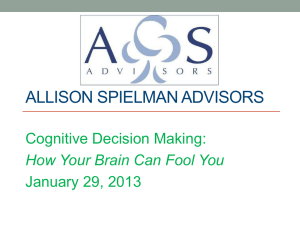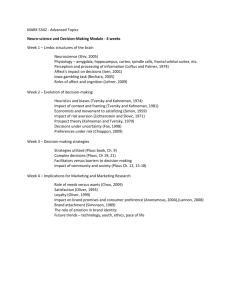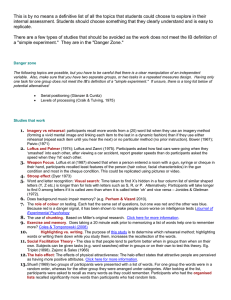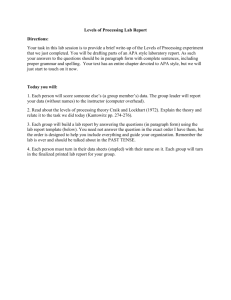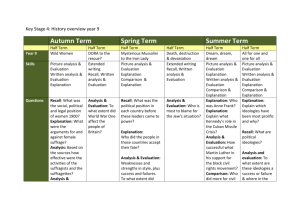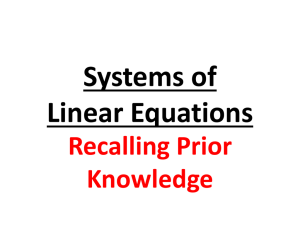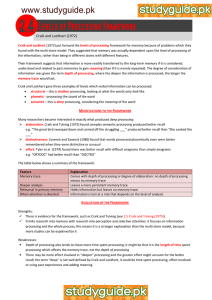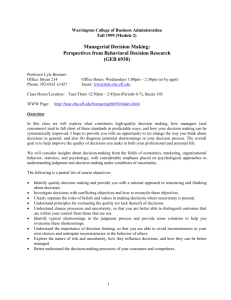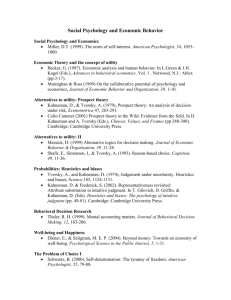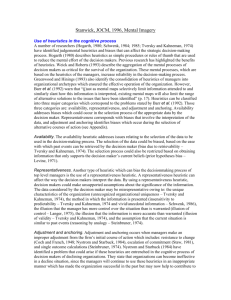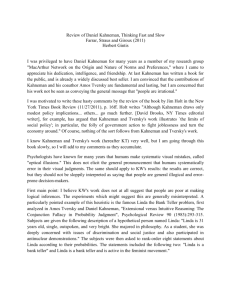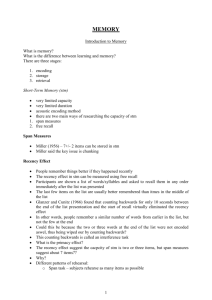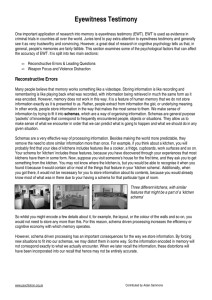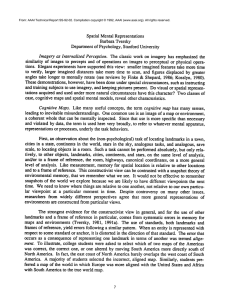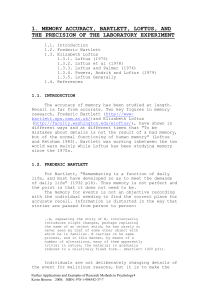Internal Assessment ideas
advertisement
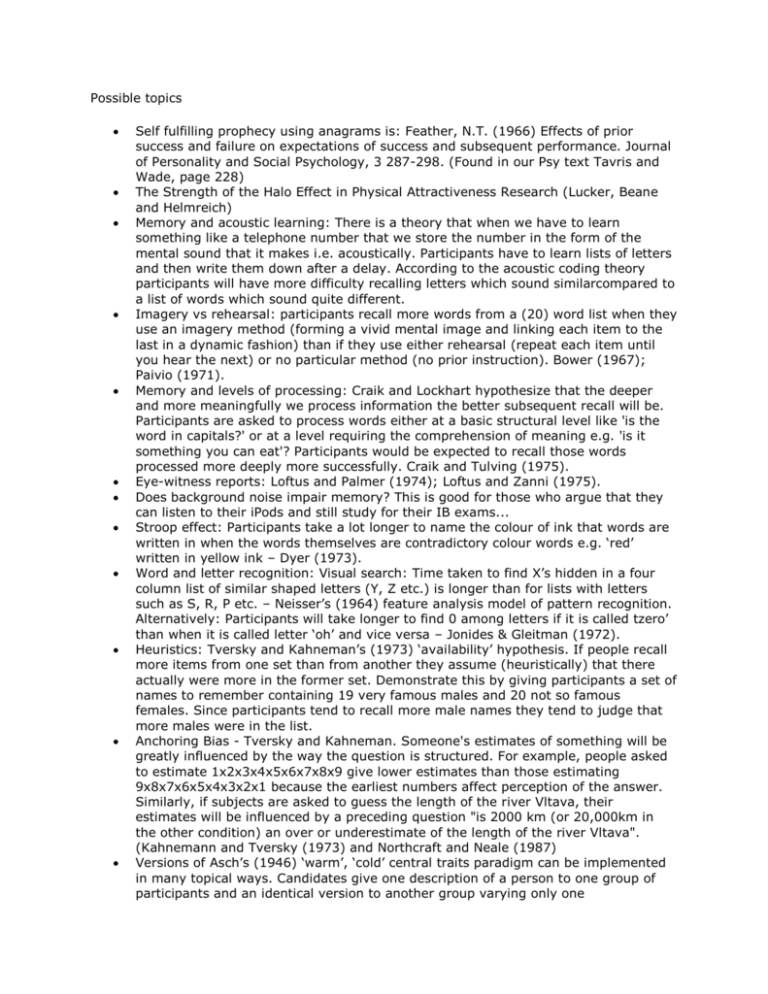
Possible topics Self fulfilling prophecy using anagrams is: Feather, N.T. (1966) Effects of prior success and failure on expectations of success and subsequent performance. Journal of Personality and Social Psychology, 3 287-298. (Found in our Psy text Tavris and Wade, page 228) The Strength of the Halo Effect in Physical Attractiveness Research (Lucker, Beane and Helmreich) Memory and acoustic learning: There is a theory that when we have to learn something like a telephone number that we store the number in the form of the mental sound that it makes i.e. acoustically. Participants have to learn lists of letters and then write them down after a delay. According to the acoustic coding theory participants will have more difficulty recalling letters which sound similarcompared to a list of words which sound quite different. Imagery vs rehearsal: participants recall more words from a (20) word list when they use an imagery method (forming a vivid mental image and linking each item to the last in a dynamic fashion) than if they use either rehearsal (repeat each item until you hear the next) or no particular method (no prior instruction). Bower (1967); Paivio (1971). Memory and levels of processing: Craik and Lockhart hypothesize that the deeper and more meaningfully we process information the better subsequent recall will be. Participants are asked to process words either at a basic structural level like 'is the word in capitals?' or at a level requiring the comprehension of meaning e.g. 'is it something you can eat'? Participants would be expected to recall those words processed more deeply more successfully. Craik and Tulving (1975). Eye-witness reports: Loftus and Palmer (1974); Loftus and Zanni (1975). Does background noise impair memory? This is good for those who argue that they can listen to their iPods and still study for their IB exams... Stroop effect: Participants take a lot longer to name the colour of ink that words are written in when the words themselves are contradictory colour words e.g. ‘red’ written in yellow ink – Dyer (1973). Word and letter recognition: Visual search: Time taken to find X’s hidden in a four column list of similar shaped letters (Y, Z etc.) is longer than for lists with letters such as S, R, P etc. – Neisser’s (1964) feature analysis model of pattern recognition. Alternatively: Participants will take longer to find 0 among letters if it is called tzero’ than when it is called letter ‘oh’ and vice versa – Jonides & Gleitman (1972). Heuristics: Tversky and Kahneman’s (1973) ‘availability’ hypothesis. If people recall more items from one set than from another they assume (heuristically) that there actually were more in the former set. Demonstrate this by giving participants a set of names to remember containing 19 very famous males and 20 not so famous females. Since participants tend to recall more male names they tend to judge that more males were in the list. Anchoring Bias - Tversky and Kahneman. Someone's estimates of something will be greatly influenced by the way the question is structured. For example, people asked to estimate 1x2x3x4x5x6x7x8x9 give lower estimates than those estimating 9x8x7x6x5x4x3x2x1 because the earliest numbers affect perception of the answer. Similarly, if subjects are asked to guess the length of the river Vltava, their estimates will be influenced by a preceding question "is 2000 km (or 20,000km in the other condition) an over or underestimate of the length of the river Vltava". (Kahnemann and Tversky (1973) and Northcraft and Neale (1987) Versions of Asch’s (1946) ‘warm’, ‘cold’ central traits paradigm can be implemented in many topical ways. Candidates give one description of a person to one group of participants and an identical version to another group varying only one characteristic, for instance ‘agrees with nuclear testing’ for one group and ‘disagrees....’ for the other. They then ask participants to assess the fictitious person on, say, liking or trustworthiness on a 10 point scale and look for differences between groups. Asch’s ‘primacy’ effect can also be tested using a list of descriptors – e.g. ‘orderly entertaining humble cool calculating moody’ in that order for one group and in the opposite order for another. Those hearing the positive traits first might rate the person more favourably on a ten point scale – Anderson and Barrios (1961). Luria and Rubin (1974) – participants given the same picture of a baby but one group told it is male the other female. Record differences in descriptions. It is best to give a checklist to participants containing ‘typical’ masculine and feminine traits – fine featured, strong, robust, sensitive, cute, and delicate. Social inference : Do people over-estimate the number of beads in a jar if they see a list of other peoples "over-estimates?" i.e. do they base their estimates on other peoples' views? Social facilitation: The idea is that people tend to perform better when in groups than when on their own. Subjects can be given tasks (e.g. word searches) either in groups or on their own to test this theory.
